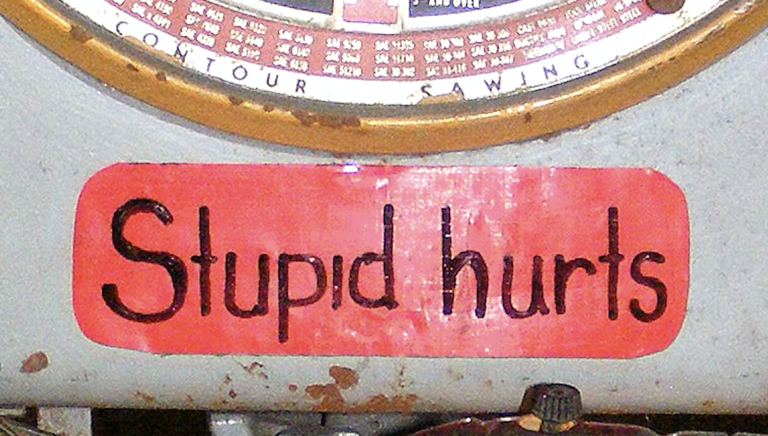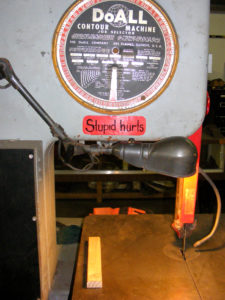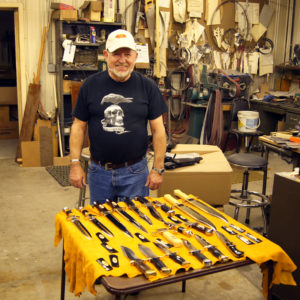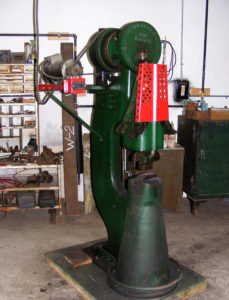
Inattentive operators are more dangerous than the machines themselves
BY JOE SZILASKI BLADE® FIELD EDITOR
“I am a newbie to knifemaking with a limited budget for machines and tools. My main concern is the horror stories I have heard concerning the accidents some makers have experienced working with their machinery. I would like to know what you think are the most dangerous machines in the shop.” -John, Pennsylvania
This is one of the most frequently asked questions I have from students attending my knifemaking classes. If I were to categorize all the tools in my shop, I am not sure which tool would be the winner of “most dangerous.” Whether a power tool or not, they are all dangerous, some more than others. Therefore, I have a lot of respect for even the simplest of knifemaking tools.
I have a sign in my shop styled like a big bandage that reads “Stupid Hurts,” and that is about the size of it. Stupidity is the cause of many accidents. Accidents happen but are often preventable.

1: GRINDER
I would like to mention a few tools found in most every maker’s shop. Let’s start with the grinder. My grinders are equipped with 2×72-inch belts and are very safe until you exert extra pressure to remove excess material faster. In a good scenario you will burn your finger from friction heat; worse, you slip and grind your knuckles, what you would call really bare knuckles, or give yourself a manicure by grinding right into your nails. Of course, the belt can snap and hit you in the forehead, reminding you to not apply too much pressure when grinding.
I teach my students to grind their knives freehand, no gloves and without the use of a tool rest. The blade can get caught between the rest and the contact wheel. This could get your fingers where they do not belong, snap your belt, or throw the blade out of your hand. I am glad I learned to grind this way and so have all of my students.
2: DRILL PRESS
The drill press looks quite innocent but most drill bits are very brittle. If you put more pressure on your drill bit than it can take, it could break or explode into small pieces and make you look like you had a fight with a porcupine. Or, the bit can snag the material you are drilling and snatch it out of your hand. Before you are able to move your hand away, the snagged material will smack you at least 10 times.
3: BAND SAW
The band saw can be an intimidating creature. I put it into the meat-eater category along with T-Rex and a pool of piranhas. To avoid all those teeth, use push sticks. Again, use just enough pressure to cut the material—nothing more, nothing less.
4: BUFFER
As most makers will tell you, the buffer is certainly one of the most dangerous tools in the shop. It may sound funny but my ex-partner wore a homemade plywood apron for when he was buffing.
Avoid putting your buffer on a workbench against a wall. I made this mistake in my old shop. I had a 1-horsepower buffer. One day the soft buffing wheel caught a guard I was working on and grabbed the knife out of my hand. The knife hit the table, ricocheted into the cinder block wall, and went right through the thin section of cinder block. I would hate to think what would happen if the blade had hit me with that much force.

Many years ago, Gil Hibben was buffing a blade when the buffer grabbed the knife and hurled it blade first into one of his main arteries. Miraculously, a friend was nearby and got Gil to the hospital before he bled to death. (Carter photo)
I replaced the buffer with a small quarter-horsepower model I could practically stop with my hand. I compensated for the lack of horsepower by sanding my knives with a higher-grit paper to make it easier for the small buffer to get the polish I wanted.
Now that I have a big dream of a shop with plenty of room for all the tools, I have that big buffer on a pedestal and away from anything that a blade can ricochet off. The buffer may still throw the blade toward my leg or foot causing a very nasty injury, but it is less likely to come toward my body.
5: POWER HAMMER
Since I forge most of my blades, about 20 years ago I bought a 50-pound Little Giant power hammer to make my life easier. This piece of equipment can be one hell of a potato masher, and then some.
Early on I developed one good habit. Whenever I stepped away from any power tool, I shut it down. That habit paid off one day. I had just shut my power hammer off when I lost my footing. My reflexes kicked in and I grabbed something to regain my balance. That is when I realized my left hand had grabbed the anvil of the power hammer, and my foot was on the pedal that would have activated the hammer. If the hammer had been turned on, my hand would now make a good stop sign at a school crossing. After that I installed an on/off switch directly on the machine and close by so I do not have to step away from the machine to shut it off. I also got the surgery on my foot I had been avoiding so now I do not lose my footing so easily.

Recently a friend of mine had a similar situation—tripping and accidentally grabbing the anvil of his air hammer. Unfortunately, his hammer was turned on. Fortunately, the doctors were able to save his three fingers that were crushed.
Tools are made to help us, not hurt us. It is true tools do not have feelings and do not care what they cut, smash or maim. You do not have to be afraid of your tools but, like I mentioned earlier, you certainly have to respect them.
In my opinion, people who do not know how to operate the tools properly are much more dangerous to themselves and others than the tools themselves. Knowing how to use your power equipment is most important in order to avoid the horror stories we have all heard about. All power tools come with lengthy warning labels. There is a good reason for these besides the manufacturer covering their you-know-whats from lawsuits. Such accidents have happened before and it is up to you to avoid having the same ones in the future.
Long ago I worked in an art foundry that made bronze sculptures. One young lady was using a hydraulic roller she was not qualified to use. Her gloves were way too big for her and the roller caught the tip of her glove and pulled in her whole hand. She has had quite a few surgeries to reattach and rebuild what the doctors could. She was lucky the maintenance guy was passing by and hit the reverse switch. He may have saved her life, as the machine was big enough to pull her in completely.
CREATE A SAFE ENVIRONMENT
Create a safe environment for your shop. Be sure to not overcrowd it. Keep things off the floor you can trip on, especially in the area around your power tools. And always maintain your tools—it is a pleasure to work on well-maintained equipment. Finally, wear proper fitting clothes and safety gear when appropriate.
Remember the basics. Do not rush or use power tools when you are too tired. Never be overconfident around power tools no matter how many years you have worked with them. I have seen people crippled and killed because of this. Sorry to add to your horror story, but the bottom line is you are the one with the brain and common sense—use both.
Send your questions for Wayne Goddard or Joe Szilaski to BLADE®, POB 789, Ooltewah, TN 37363-0789 steve.shackleford@fwmedia.com. Include a self-addressed, stamped envelope with your name and address for a personal response from Wayne, or e-mail him at wgoddard44@comcast.net. E-mail Joe at joe@szilaski.com. If you wish, BLADE will not print your name with your question.
 NEXT STEP: Download Your Free KNIFE GUIDE Issue of BLADE Magazine
NEXT STEP: Download Your Free KNIFE GUIDE Issue of BLADE Magazine
BLADE’s annual Knife Guide Issue features the newest knives and sharpeners, plus knife and axe reviews, knife sheaths, kit knives and a Knife Industry Directory.Get your FREE digital PDF instant download of the annual Knife Guide. No, really! We will email it to you right now when you subscribe to the BLADE email newsletter.






